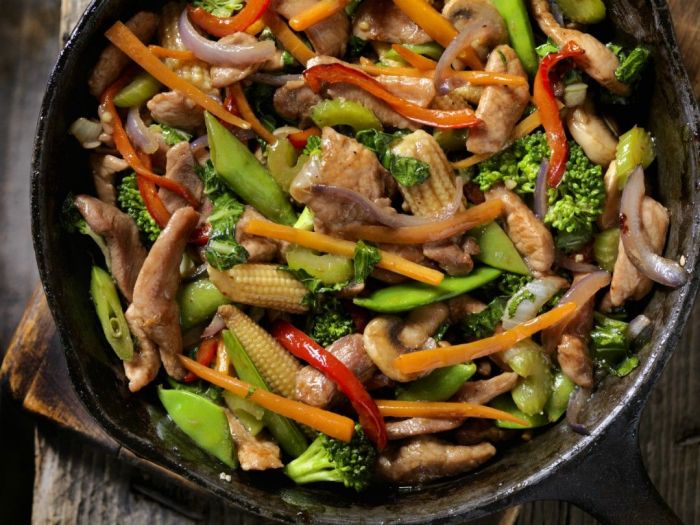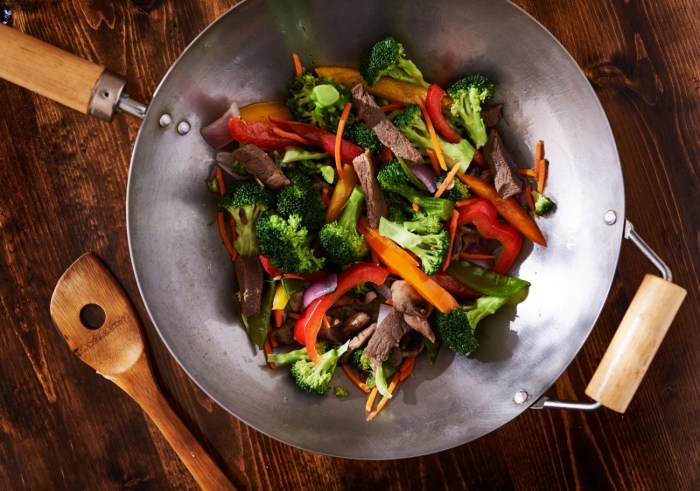Restaurant Secret Recipes for Stir-fries invites you on a culinary journey to uncover the tantalizing flavors and techniques that elevate ordinary stir-fries into extraordinary dishes. From the sizzling wok to the vibrant ingredients, prepare to embark on a gastronomic adventure that will transform your home cooking.
Throughout this comprehensive guide, we’ll delve into the essential ingredients and their harmonious interplay, explore the mastery of stir-frying techniques, and uncover the secret recipes that have tantalized taste buds in renowned restaurants.
Stir-Fry Ingredients and Their Significance
Stir-fries are a versatile dish that can be customized to your liking. The key to a great stir-fry is using the right ingredients. Here’s a breakdown of the essential ingredients and their significance:
Vegetables
Vegetables are the foundation of any stir-fry. They provide color, texture, and nutrients. Some of the most common vegetables used in stir-fries include:
- Broccoli: Adds a slightly bitter flavor and a satisfying crunch.
- Carrots: Provide sweetness and a vibrant orange color.
- Bell peppers: Available in a variety of colors, they offer a mild, slightly sweet flavor.
- Snow peas: Add a delicate sweetness and a vibrant green color.
Proteins
Proteins are essential for adding substance and flavor to stir-fries. Common protein sources include:
- Chicken: A versatile protein that can be cut into thin strips or small cubes.
- Beef: Provides a bolder flavor and a more substantial texture.
- Pork: Offers a slightly sweet flavor and a tender texture.
- Shrimp: Adds a delicate seafood flavor and a slightly chewy texture.
Sauces
Sauces are used to add flavor and moisture to stir-fries. Some popular sauces include:
- Soy sauce: A salty and savory sauce that adds a umami flavor.
- Hoisin sauce: A thick, sweet, and slightly spicy sauce that adds a rich flavor.
- Teriyaki sauce: A sweet and slightly tangy sauce that adds a glossy glaze.
- Oyster sauce: A thick and savory sauce that adds a depth of flavor.
Seasonings
Seasonings are used to enhance the flavor of stir-fries. Common seasonings include:
- Garlic: Adds a pungent and aromatic flavor.
- Ginger: Provides a warm and spicy flavor.
- Black pepper: Adds a subtle spiciness.
- Sesame oil: Adds a nutty flavor and a glossy finish.
Ingredient Combinations and Flavor Profiles
The possibilities for ingredient combinations in stir-fries are endless. Here are a few examples of common combinations and their flavor profiles:
- Chicken and broccoli: A classic combination that offers a savory and slightly bitter flavor.
- Beef and bell peppers: A hearty combination with a sweet and slightly spicy flavor.
- Pork and snow peas: A tender and flavorful combination with a delicate sweetness.
- Shrimp and hoisin sauce: A seafood-based combination with a rich and slightly sweet flavor.
Ingredient Significance Table
Here’s a table summarizing the significance of each essential ingredient in stir-fries:
| Ingredient | Purpose | Flavor Profile | Examples |
|---|---|---|---|
| Vegetables | Provide color, texture, and nutrients | Varies depending on the vegetables used | Broccoli, carrots, bell peppers, snow peas |
| Proteins | Add substance and flavor | Varies depending on the protein used | Chicken, beef, pork, shrimp |
| Sauces | Add flavor and moisture | Varies depending on the sauce used | Soy sauce, hoisin sauce, teriyaki sauce, oyster sauce |
| Seasonings | Enhance flavor | Varies depending on the seasonings used | Garlic, ginger, black pepper, sesame oil |
Stir-Fry Techniques and Cooking Methods

Mastering the art of stir-frying involves not only understanding the ingredients but also the techniques and cooking methods that bring out their full potential. Stir-frying is a dynamic culinary technique that requires precision, coordination, and an understanding of heat control.
Essential Stir-Frying Techniques
- Tossing: A gentle but firm motion used to lift and turn ingredients, ensuring even cooking and preventing them from sticking to the wok or pan.
- Flipping: A quick, controlled movement that flips ingredients over, allowing them to cook evenly on both sides.
- Wok Hei: A technique that involves using a well-seasoned wok over high heat to create a smoky, charred flavor and aroma in the dish.
Importance of Heat Control and Timing
Heat control and timing are crucial in stir-frying. High heat is necessary to quickly sear ingredients, retaining their crispness and flavor. However, it’s equally important to adjust the heat as needed to prevent burning or overcooking. Timing is essential to ensure that each ingredient is cooked to its optimal texture and doneness, creating a harmonious balance of flavors and textures.
Secret Recipes and Their Origin
Renowned restaurants across the globe have carefully guarded secret recipes for stir-fries, which have become culinary treasures passed down through generations. These recipes have played a pivotal role in shaping culinary traditions and continue to tantalize taste buds worldwide.
Over time, these recipes have undergone subtle yet significant transformations, reflecting evolving tastes and the influence of different cultures. The key ingredients, cooking techniques, and presentation styles have been meticulously refined to create dishes that are both authentic and captivating.
Famous Restaurant Secret Recipes
Here is a glimpse into some of the most celebrated restaurant secret recipes for stir-fries, along with their historical origins and key ingredients:
| Recipe Name | Restaurant | Origin | Key Ingredients |
|---|---|---|---|
| Kung Pao Chicken | P.F. Chang’s | Chinese | Chicken, peanuts, red chili peppers, Szechuan peppercorns |
| Orange Chicken | Panda Express | Chinese-American | Chicken, orange zest, orange sauce, sesame oil |
| Pad Thai | Thai Basil | Thai | Rice noodles, tamarind sauce, peanuts, bean sprouts |
| Bulgogi Stir-Fry | Kang Ho Dong Baekjeong | Korean | Thinly sliced beef, soy sauce, garlic, sesame oil |
Variations and Adaptations of Stir-Fries
Stir-fries have evolved and adapted across different regions, showcasing unique culinary traditions and flavors. Each regional variation incorporates distinctive ingredients, flavors, and cooking methods, resulting in a diverse range of stir-fry dishes.
Have you ever wondered how your favorite stir-fry dish at your go-to restaurant always seems to taste so good? It might be because they have a secret recipe! Cooking is a fantastic way to celebrate different cultures, and experimenting with new recipes is a great way to do just that.
If you’re looking to expand your culinary horizons, check out Celebrating food and culture through cooking for some inspiration. You might just find a new favorite dish to add to your repertoire. And who knows, you might even be able to recreate that restaurant-quality stir-fry at home.
Chinese Stir-Fries
Chinese stir-fries are renowned for their bold flavors and vibrant colors. They typically use a variety of vegetables, such as bok choy, carrots, and snow peas, along with a protein source like chicken, beef, or tofu. Chinese stir-fries often incorporate a flavorful sauce made with soy sauce, oyster sauce, or hoisin sauce, which adds a rich and savory taste.
Thai Stir-Fries
Thai stir-fries are characterized by their aromatic flavors and use of fresh herbs. They often incorporate a balance of sweet, sour, salty, and spicy flavors. Common ingredients include vegetables like bell peppers, onions, and carrots, along with a protein source like shrimp, chicken, or tofu. Thai stir-fries are often flavored with a blend of fish sauce, lime juice, and chili peppers, creating a vibrant and flavorful dish.
The secret recipes for stir-fries used by restaurants can tantalize your taste buds. If you’re looking for unique recipes to try at home, there are plenty of resources available online. Unique recipes for home cooks can be found on websites and blogs, offering a wide range of flavors and cuisines to explore.
Don’t miss out on the opportunity to recreate your favorite restaurant stir-fries in the comfort of your own kitchen.
Vietnamese Stir-Fries
Vietnamese stir-fries, also known as “xao,” are known for their light and refreshing flavors. They typically use a variety of vegetables, such as bean sprouts, carrots, and onions, along with a protein source like chicken, beef, or tofu. Vietnamese stir-fries are often seasoned with a blend of fish sauce, garlic, and black pepper, resulting in a savory and aromatic dish.
Ingredients to Avoid and Common Mistakes

Stir-frying is a technique that requires careful ingredient selection and precise execution. To achieve the best results, it’s crucial to avoid certain ingredients and steer clear of common mistakes.
Here are some ingredients that should be avoided in stir-fries and the reasons why:
Ingredients to Avoid, Restaurant secret recipes for stir-fries
- Dairy products: Milk, cream, and cheese can curdle or separate when exposed to high heat, ruining the texture of the stir-fry.
- Tough meats: Meats like brisket or chuck roast require slow cooking methods and are not suitable for stir-frying, as they will become tough and chewy.
- Large pieces of vegetables: Vegetables should be cut into bite-sized pieces to ensure even cooking and prevent burning.
- Starchy vegetables: Vegetables like potatoes and squash contain a lot of starch, which can release water and make the stir-fry soggy.
- Frozen vegetables: Frozen vegetables often contain excess water, which can dilute the sauce and make the stir-fry watery.
In addition to avoiding these ingredients, there are also some common mistakes that can be made when stir-frying. Here are some tips to help you avoid these mistakes:
Common Mistakes
- Overcrowding the pan: Overcrowding the pan will prevent the ingredients from cooking evenly and can result in a soggy stir-fry.
- Not preheating the pan: A hot pan is essential for creating a good sear on the ingredients and preventing them from sticking.
- Using too much oil: Too much oil can make the stir-fry greasy and heavy.
- Cooking the ingredients for too long: Overcooked ingredients will become tough and lose their flavor.
- Adding the sauce too early: The sauce should be added towards the end of cooking to prevent it from burning.
| Ingredient/Mistake to Avoid | Reason |
|---|---|
| Dairy products | Curdling or separation when exposed to high heat |
| Tough meats | Become tough and chewy when stir-fried |
| Large pieces of vegetables | Uneven cooking and burning |
| Starchy vegetables | Release water and make the stir-fry soggy |
| Frozen vegetables | Excess water can dilute the sauce and make the stir-fry watery |
| Overcrowding the pan | Uneven cooking and soggy stir-fry |
| Not preheating the pan | Ingredients stick and do not sear properly |
| Using too much oil | Greasy and heavy stir-fry |
| Cooking the ingredients for too long | Tough and flavorless ingredients |
| Adding the sauce too early | Sauce burns |
Health Benefits and Nutritional Value: Restaurant Secret Recipes For Stir-fries
Stir-fries are not only delicious but also incredibly nutritious. They are packed with vitamins, minerals, and antioxidants that offer numerous health benefits.
The high fiber content in stir-fries aids digestion, promotes satiety, and helps regulate blood sugar levels. The abundance of vitamins, such as vitamin A, vitamin C, and folate, supports immunity, skin health, and overall well-being. Minerals like potassium, magnesium, and iron contribute to electrolyte balance, nerve function, and red blood cell production.
Antioxidants in stir-fries, such as beta-carotene, lutein, and zeaxanthin, protect cells from damage caused by free radicals. These antioxidants have been linked to reduced risks of chronic diseases, including heart disease and certain types of cancer.
Tailoring Stir-fries to Dietary Needs
Stir-fries are highly customizable, making them suitable for various dietary needs and preferences. They can be tailored to accommodate vegan, vegetarian, gluten-free, low-carb, and high-protein diets.
For vegans and vegetarians, tofu, tempeh, and edamame can be used as protein sources. Gluten-free options include rice noodles, quinoa, and buckwheat noodles. Low-carb stir-fries can be made with shirataki noodles or by using more vegetables and fewer noodles. High-protein stir-fries can be created by adding lean meats, poultry, or seafood.
Nutritional Content Table
| Nutrient | Benefits | Food Sources | Serving Size |
|—|—|—|—|
| Vitamin A | Vision, immune function | Carrots, bell peppers, spinach | 1 cup cooked |
| Vitamin C | Immune function, skin health | Broccoli, cauliflower, snap peas | 1 cup cooked |
| Folate | Cell growth, red blood cell production | Asparagus, leafy greens, beans | 1 cup cooked |
| Potassium | Electrolyte balance, nerve function | Potatoes, tomatoes, mushrooms | 1 cup cooked |
| Magnesium | Bone health, muscle function | Almonds, cashews, tofu | 1/4 cup |
| Iron | Red blood cell production | Lean meats, poultry, leafy greens | 3 ounces cooked |
| Beta-carotene | Antioxidant, protects against heart disease | Carrots, sweet potatoes, pumpkin | 1 cup cooked |
| Lutein | Antioxidant, protects against eye diseases | Spinach, kale, collard greens | 1 cup cooked |
| Zeaxanthin | Antioxidant, protects against eye diseases | Corn, yellow peppers, eggs | 1 cup cooked |
Tips for Creating Restaurant-Quality Stir-Fries at Home
Achieving restaurant-quality stir-fries at home is a matter of technique and attention to detail. By following these tips, you can elevate your stir-fries to new heights.
First and foremost, use fresh, high-quality ingredients. The freshness of the vegetables will contribute to the overall flavor and texture of the dish. Secondly, season your stir-fries properly. A good balance of salty, sweet, and savory flavors is key.
Finally, master the cooking techniques. Stir-frying is a quick-cooking method that requires high heat and constant stirring. By following these tips, you can create restaurant-quality stir-fries at home that will impress your family and friends.
Essential Tips for Restaurant-Style Stir-Fries
- Use fresh, high-quality ingredients.
- Season your stir-fries properly.
- Master the cooking techniques.
- Use a well-seasoned wok or skillet.
- Heat the wok or skillet over high heat.
- Add the oil and swirl to coat the pan.
- Add the vegetables and stir-fry until tender.
- Add the sauce and cook until the vegetables are coated.
- Serve immediately over rice or noodles.
Final Review
As we reach the end of our culinary exploration, let’s not forget the lessons we’ve learned. With the right ingredients, techniques, and a touch of inspiration, you can recreate restaurant-quality stir-fries in the comfort of your own kitchen. Experiment, adapt, and let your creativity shine through. Remember, the true secret to a delicious stir-fry lies in the joy of cooking and sharing it with loved ones.


